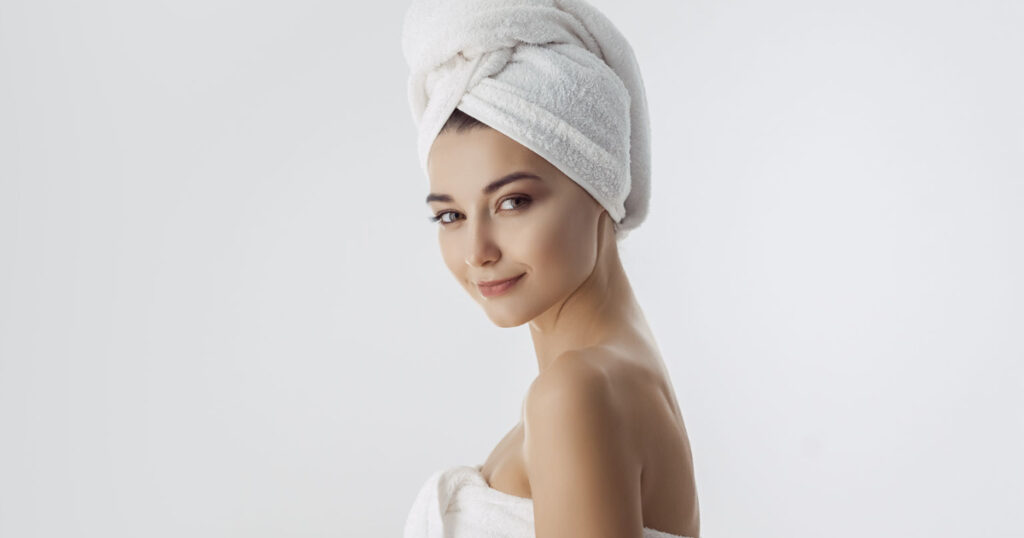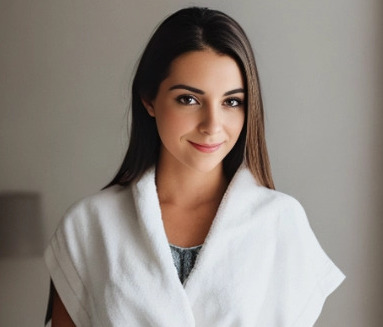Hair towels are a relatively new addition to the hair-care and beauty market, though they are quickly replacing the heavy, bulky bath towels many people have traditionally wrapped around their heads after a shower or bath.

Made from ultra-absorbent microfiber or cotton materials, quick-dry hair towels are perfect for all hair types and textures — including curly, straight, fine, thick, color-treated, and damaged hair. They gently remove excess moisture from hair to speed up drying time.
A hair towel’s clever design includes a way to secure it in place on your head, allowing you to go about your morning routine while your hair dries under the towel. This hands-free approach protects hair from damage while absorbing moisture.
Key Benefits of Using a Hair Towel
There are several reasons why using a hair towel can benefit your daily hair care routine:
- Prevents hygral fatigue. Leaving hair saturated in water too long causes cuticles to expand and contract repeatedly, leading to hygral fatigue. This damages hair over time, causing dullness, brittleness, increased shedding, and lack of elasticity. Hair towels wick away moisture quickly to minimize hygral fatigue.
- Frees up your hands. Well-designed hair towels stay securely twisted on your head without needing to be held in place. This allows you to multitask while your hair dries.
- Less frizz. The smooth, gentle fabric of a hair towel creates less friction than a cotton towel, smoothing down cuticles to reduce frizz.
- Maintains curl pattern. Hair towels don’t disrupt curl patterns by avoiding the need to rub hair dry. This prevents frizz and maintains the integrity of curls.
- Faster drying. Microfiber and cotton hair towels hold more water than regular bath towels. By absorbing excess moisture, they dramatically cut down on drying time before heat styling.
- Lightweight comfort. Hair towels are made from lightweight materials that don’t strain your neck and shoulders like a soaked bath towel can.
- Enhances hair treatments. Wearing a hair mask or deep conditioner under a hair towel allows the products to penetrate better for improved results.
Hair Towel Materials: Cotton vs. Microfiber

The two most common fabrics used to make hair towels are cotton and microfiber. Here’s how they compare:
100% Cotton
- Extremely absorbent material, capable of soaking up to 27 times its weight in water. The fibers have capillary action that “wicks” away moisture.
- Environmentally friendly, biodegradable, and made from a renewable resource.
- Gets stronger when wet to resist wear and tear.
- Soft, breathable, and gentle on hair.
- Terry cloth cotton is ideal for hair towels thanks to its fluffy loops that absorb water well.
Microfiber
- Made from ultra-fine synthetic fibers that create a smooth, polished surface.
- Even more absorbent than cotton, able to hold up to 7 times its weight in water.
- Dries hair very quickly and wicks moisture away from strands.
- Creates less friction against the hair to reduce frizz and damage.
- Extremely lightweight and fast-drying. Easy to travel with.
- Provides a gentle “polishing” effect to boost shine.
- Available at very affordable price points.
Both cotton and microfiber make excellent hair towel fabrics. 100% cotton is ideal if you want an eco-friendly option, while microfiber offers advanced absorbency and frizz reduction.
How To Use a Hair Towel for Best Results

Using a hair towel is quick and easy. Follow these steps:
- Shampoo and condition hair as usual. Rinse thoroughly.
- Flip the head upside down and gently squeeze out excess moisture.
- Place a towel at the nape of your neck and wrap the hair up in the towel, twisting it around the hair.
- Secure the twist in place by looping the ends through the elastic or button closure.
- Keep the towel on for at least 20-30 minutes while hair dries.
- Unwrap the towel and style your hair as desired.
For optimal results, use a hair towel after every shampoo. Wring out as much moisture as possible before wrapping hair to speed up drying time. If you have very thick or long hair, extend the drying time under the towel to 40-60 minutes.
Best Hair Towels to Try
Here are some top-rated hair towel options to consider:
- Aquis Rapid Dry Hair Turban – Made of proprietary Aquitex fabric that cuts drying time significantly. Ideal for fragile or thin hair.
- Turbie Twist Microfiber Hair Towels – Absorbent microfiber gently dries all hair types. Provides lightweight comfort and hands-free drying.
- Bouclème Terry Cotton Hair Towel – Organic cotton/bamboo blend is perfect for curly or coiled hair types. Super gentle.
- Kitsch Jersey Microfiber Towel – Lightweight microfiber towel earned rave reviews for its quick-drying abilities. Cute prints.
- Coco & Eve Microfiber Hair Wrap – Silky lightweight material dries hair gently while reducing frizz. Fun designer prints.
- DuraComfort Anti-Frizz Microfiber Hair Towel – Generously sized towel suits long, thick hair. Smooths and dries hair effectively.
- Aquis Lisse Luxe Hair Turban – Innovative fabric holds moisture without absorbing oils or products from hair.
The Key Benefits of Hair Towels
In summary, hair towels provide an easy, affordable way to gently dry hair while avoiding damage, frizz, and breakage. They are more absorbent, lightweight, and gentler on hair than regular cotton towels.
Using a hair towel speeds up drying time, allowing you to get ready faster in the mornings. It also helps hair care products penetrate more effectively when used with masks or treatments.
Switching to a hair towel helps maintain healthy, manageable, frizz-free hair. Give one a try to make your daily hair care routine easier!
FAQs
What exactly are hair towels?
Hair towels are towels made specifically for drying hair gently. Unlike regular cotton bath towels, they are made from ultra-absorbent fabrics like microfiber or high-quality cotton. The smooth, lightweight materials are perfect for quickly absorbing moisture from hair after washing. Hair towels are much smaller than bath sheets and fasten at the nape of the neck for hands-free drying.
How are hair towels different from bath towels?
Bath towels are made from materials like terrycloth or cotton that can snag and damage wet hair. They are also much larger, heavier, and bulkier. Hair towels are designed to be gentle, lightweight, and secure on your head. The compact size uses less fabric to keep costs low. Hair towels use smooth, polished fabrics that glide over hair without friction.
When should you use a hair towel?
Use a hair towel after every time you wash your hair. It is meant to be used in place of a regular bath towel to dry your hair. Wrap your hair in the towel after showering, bathing, or washing your hair. Allow your hair to dry under the towel for 20-60 minutes depending on thickness. Then unwrap style, and finish drying with a blow dryer or air dry the rest of the way.
What materials are best for hair towels?
The two most common fabrics are microfiber and 100% cotton. Microfiber is extremely lightweight and absorbent. It creates less friction for minimized frizz and damage. High-quality cotton is super gentle and soft but not as lightweight. Terry cotton cloth makes very absorbent hair towels. Both microfiber and cotton work well to safely dry all hair types and textures.
How do you properly use a hair towel?
After washing hair, gently squeeze out excess water. Place the towel at your nape, pull your hair up onto your head, and twist it around your hair. Secure the twist by looping the ends through the closure. Keep wrapped for 20-60 minutes based on your hair’s thickness. Then unwrap, style, and finish drying as needed. Use a hair towel after each wash for best results.
Conclusion
Switching to a high-quality hair towel provides many benefits for your daily hair care.
Hair towels speed up drying time, reduce frizz, maintain the integrity of curls, allow you to multitask hands-free, and prevent hygral fatigue from excessive moisture exposure.
Their lightweight, hair-friendly materials make hair towels an easy way to avoid damage while caring for your locks.





